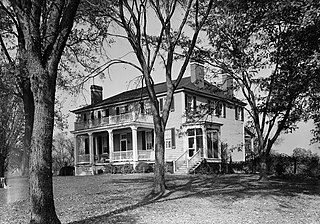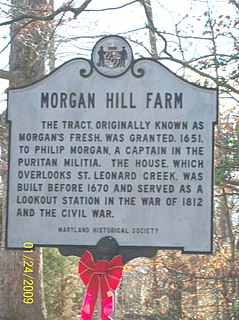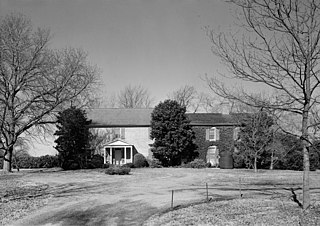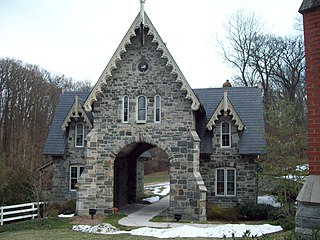
The Cove Point Light is a lighthouse located on the west side of Chesapeake Bay in Calvert County, Maryland.

The William B. Tennison is a Chesapeake Bay bugeye built in 1899 and converted to an oyster buy-boat in 1906–07. With the conversion her sail rig was removed and an engine inserted, and is the only surviving example of this conversion. Her construction marks a transition between log construction and plank construction. She is homeported at the Calvert Marine Museum in Solomons, Maryland. The Tennison is reputed to be the second oldest licensed passenger vessel in the United States.

The College of Medicine of Maryland, or also known since 1959 as Davidge Hall, is a historic domed structure in Baltimore, Maryland. It has been in continuous use for medical education since 1813, the oldest such structure in the United States. A wide pediment stands in front of a low, domed drum structure, which housed the anatomical theater. A circular chemistry hall was housed on the lower level under the anatomical theater.

Riversdale, is a five-part, large-scale late Georgian mansion with superior Federal interior, built between 1801 and 1807. Also known as Baltimore House, Calvert Mansion or Riversdale Mansion, it is located at 4811 Riverdale Road in Riverdale Park, Maryland, and is open to the public as a museum.

Cedar Hill is a historic home located on 75 acres (300,000 m2) at Barstow, Calvert County, Maryland, United States. It is one of the few remaining cruciform dwelling houses existing in Maryland, built in the 18th century that is typical of 17th-century architecture. It is a 1+1⁄2-story house with a 2-story porch tower, built of brick laid in Flemish bond. It is now operated as a bed and breakfast, meeting hall, and retreat center.

Cornehill is a historic home located at Parran, Calvert County, Maryland, United States. It is a five-bay-long two-story Georgian brick house laid in Flemish bond with a steeply pitched gable roof with an exterior chimney at each gable end. One brick on the southwest corner contains the date 1786 and the initials "T.F." The initials purportedly refer to Thelbert Freeland, a member of an influential family in northeastern Calvert County. Outbuildings include slave quarters to the south of the house, and a tobacco barn with oak framing. During the majority of the 18th century, the Mackall family, large Calvert County landowners, held Cornehill, or "Cornhill."

Grahame House, Graham House, Mansion House, Graeme House, or Patuxent Manor, is a historic home located at Lower Marlboro, Calvert County, Maryland. It is an 18th-century original 1+1⁄2-story brick shell laid in Flemish bond with a steeply pitched gable roof. Later alterations have included the purchase and removal of the fine paneling throughout the house to the Henry Francis du Pont Winterthur Museum. Charles Grahame, for whom the home is named, was associated with Frederick Calvert, sixth Lord Baltimore, through Grahame's brother, David Grahame and with Thomas Johnson, first elected Governor of the State of Maryland, through Grahame's son.

Linden is a historic home located at Prince Frederick, Calvert County, Maryland. It is a two-story frame house, conservatively Italianate in style built about 1868, with conservative Colonial Revival additions of about 1907. Behind the house are ten standing outbuildings, seven dating to the 19th century, three of which are of log construction. It is home to the Calvert County Historical Society.

Preston-on-the-Patuxent is a historic home located at Johnstown, Calvert County, Maryland, United States. It is a modest 1+1⁄2-story brick house which has had several later additions made to it. While the home has a traditional construction date of about 1651, there is no structural evidence to indicate a date earlier than about 1725. It has been reported by Puritan knowledge that the original Preston home burned down in 1672, to be replaced by the present structure at a later date. Preston-on-the-Patuxent is popularly, if erroneously, known as the seat of the government of Maryland from 1654 to 1657, during the Puritan regime. The belief that the property was the "capital" comes from evidence that the Council, the Assembly, and the Provincial Court met "at Patuxent" in the 1650s. Richard Preston, a participant in each of the three bodies, most probably hosted their meetings in his dwelling located near the Patuxent River.

Taney Place is a historic home located at Adelina, Calvert County, Maryland, United States. It is a simple, two-story, hip-roofed, Georgian-style country house, dating from about 1750. It was the birthplace and childhood home of Roger Brooke Taney (1777–1864), who served as Chief Justice of the Supreme Court of the United States from 1836 to 1864.

Morgan Hill Farm, also known as Morgan's Fresh or Hill Farm, is a historic home located at Lusby, Calvert County, Maryland. It is a 1+1⁄2-story gable-roofed frame house of a T-shaped plan, with single exterior chimneys on each of the three exposed ends. The original building appears to have been built about 1700, with extensively remodeled in the early 19th century. In 1952 a large rear wing was added to the house. Outbuildings include a one-story log servants' quarter, a log smokehouse, and a large tobacco barn.

All Saints' Church is a historic Episcopal church located at 100 Lower Marlboro Road, in Sunderland, Calvert County, Maryland. All Saint's Parish was one of the thirty original Anglican parishes created in 1692 to encompass the Province of Maryland. In 1693 its first parish church, a log structure, was built on an acre of land called Kemp's Desire donated by Thomas Hillary. This log church was expanded in 1703-1704 and repaired at least 4 times before being replaced on top of the hill between MD routes 4, 262, and 2 by the present brick building.

Middleham Chapel is a historic Episcopal church located in Lusby, Calvert County, Maryland. It is a one-story, cruciform, Flemish bond brick structure with exposed fieldstone foundations. It was built in 1748, to replace an earlier frame or log structure believed to have been erected as early as 1684, as a Chapel of Ease of Christ Church Parish. The date of construction is worked into the brick on the front of the church.

The Chesapeake Beach railway station is a historic railway station located at Chesapeake Beach, Calvert County, Maryland, United States. It is composed of two one-story, hip-roofed sections; one part was once an open passenger boarding area that was later enclosed for storage. The station was erected in 1898, for the Chesapeake Beach Railway. It is now operated as a railway museum.
Green's Inheritance is a historic home located at Pomfret, Charles County, Maryland, United States. It is a 2+1⁄2-story gable-roofed house of common bond brick, built about 1850. The house has a basic Georgian plan. It is the only brick house in Charles County dating between the years 1835 and 1880. The house was built by Francis Caleb Green, on part of the 2,400 acres (970 ha) of land granted in 1666 to the sons of Thomas Greene, the second Provincial Governor of Maryland, who named it "Green's Inheritance."

The Inns on the National Road is a national historic district near Cumberland, Allegany County, Maryland. It originally consisted of 11 Maryland inns on the National Road and located in Allegany and Garrett counties. Those that remain stand as the physical remains of the almost-legendary hospitality offered on this well-traveled route to the west.

East Nottingham Meetinghouse, or Brick Meetinghouse, is a historic Friends meeting house located at Rising Sun, Cecil County, Maryland. It consists of three different sections: the Flemish bond brick section is the oldest, having been built in 1724, 30 feet 3 inches (9.22 m) by 40 feet 2 inches (12.24 m); the stone addition containing two one-story meeting rooms on the ground floor, each with a corner fireplace at the south corners of the building, and a large youth gallery on the second floor; and in the mid 19th century, a one-story gable roofed structure was added at the southwest corner of the stone section to serve as a women's cloakroom and privy. It is of significance because of its association with William Penn who granted the site "for a Meeting House and Burial Yard, Forever" near the center of the 18,000-acre (73 km2) Nottingham Lots settlement and was at one time the largest Friends meeting house south of Philadelphia. The Philadelphia Half-Yearly Meeting was held here as early as 1725. During the Revolutionary War, an American Army hospital was established here in 1778 for sick and wounded troops under General William Smallwood's command and the Marquis de Lafayette's troops camped in the Meeting House woods on the first night of their march from the Head of Elk to victory at the Battle of Yorktown in 1781.

Carroll County Almshouse and Farm, also known as the Carroll County Farm Museum, is a historic farm complex located at Westminster, Carroll County, Maryland. It consists of a complex of 15 buildings including the main house and dependencies. The 30-room brick main house was originally designed and constructed for use as the county almshouse. It is a long, three-story, rectangular structure, nine bays wide at the first- and second-floor levels of both front and rear façades. It features a simple frame cupola sheltering a farm bell. A separate two-story brick building with 14 rooms houses the original summer kitchen, wash room, and baking room, and may have once housed farm and domestic help. Also on the property is a brick, one-story dairy with a pyramidal roof dominated by a pointed finial of exaggerated height with Victorian Gothic "icing" decorating the eaves; a large frame and dressed stone bank barn; and a blacksmith's shop, spring house, smokehouse, ice house, and numerous other sheds and dependencies all used as a part of the working farm museum activities. The original Carroll County Almshouse was founded in 1852 and the Farm Museum was established in 1965.

Bowlingly, also known as Neale's Residence and The Ferry House, is a historic home located at Queenstown, Queen Anne's County, Maryland, United States. It is a large brick dwelling house constructed in 1733 on a bluff overlooking Queenstown Creek. The original house is a two-story brick structure that is seven bays long and one room deep, with flush brick chimneys at either end of the pitched gable roof. On August 13, 1813, a flotilla of British Royal Navy warships landed at Bowlingly's wharf during the War of 1812. British troops who disembarked from the warships proceeded to sack the home before being engaging the local Maryland militia.

The Sheppard and Enoch Pratt Hospital, known to many simply as Sheppard Pratt, is a psychiatric hospital located in Towson, a northern suburb of Baltimore, Maryland. Founded in 1853, it is one of the oldest private psychiatric hospitals in the nation. Its original buildings, designed by architect Calvert Vaux, and its Gothic gatehouse, built in 1860 to a design by Thomas and James Dixon, were designated a National Historic Landmark in 1971.






















